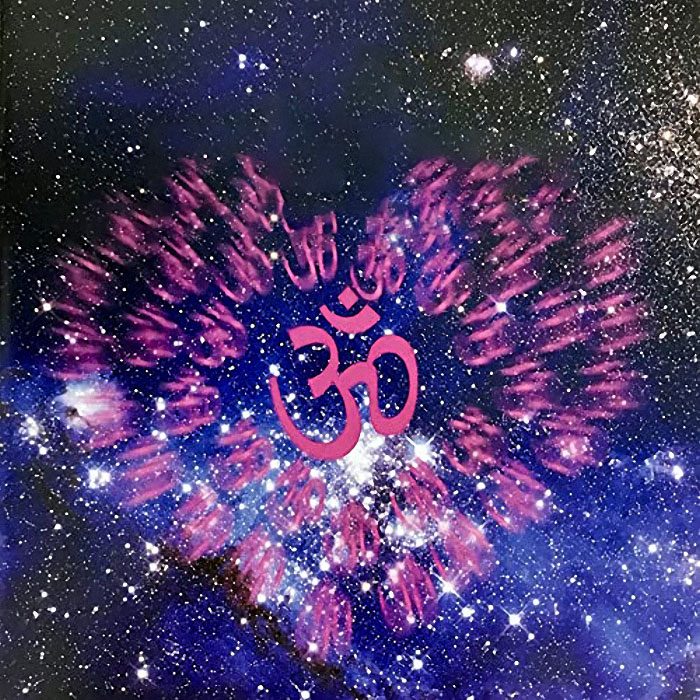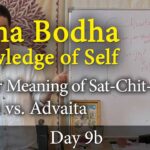Sat Chit Ananda Meaning

INQUIRER:
In my continued study of the Bhagavad Gita I am looking closely at sat-cit-ananda and would love some insights to this knowledge.
RESPONSE:
Firstly to define each word…
-
- Sat: Existence.
- Cit: Consciousness or Awareness (synonyms in Vedanta).
- Ananda: fullness or not-two or limitlessness (all mean the same, looked at from different standpoints).
Now the explanation…
This video is part of the 4-year course on the total vision of Reality.
Satchitananda is the compound used to indicate the nature of awareness (brahman), or the self (atman).
It is important to understand, however, that…
Sat is not the limited existence of ephemeral objective phenomena.
Cit is not the consciousness of perceptible objective phenomena.
Ananda is not the emotional bliss/happiness/enjoyment associated with the experience of objective phenomena.
Sat-chit-ananda indicates limitless conscious existence.
We know the nature of the self (atma) is conscious existence because existence is only recognized as such due to consciousness of it — and consciousness is self-evidently existent.
We know that conscious existence is limitless because all objective phenomena are only recognizable due to their existence within a “field” of conscious existence.
Even time and space (the fundamental parameters by which objects are defined) are objects whose existence is only recognizable due to their appearance within a “field” of conscious existence.
Thus that “field” of conscious existence itself must be beyond (i.e., not subject to) all limiting parameters and, thus, limitless.
This “field” of limitless conscious existence is referred to as the self (ātmā) — because it is the fundamental reality, or essential aspect, of all things.
And since there can be only ONE fundamental reality — thus the fundamental reality of the total must be the fundamental reality of the apparent individual. Since the apparent individual is a part of the total.
INQUIRER:
My mind can only reflect pure cit or know this infinite ever present source but in the end “I am that” meaning that all things are in my mind and all things exist in me.
RESPONSE:
All objective phenomena are only recognized by the mind and are only experienced by the individual as a result of the mental perception of the object.
But all objective phenomena do not exist solely within the mind of the individual.
There are three orders of reality:
1) paramarthika-satyam, which is pure awareness;
2) vyavaharika-satyam, which is the transactional reality; and
3) pratibhasika-satyam, which is the apparent individual’s experience.
Paramarthika-satyam alone is real.
It is the realm of pure, unmodified, limitless, attributeless, ever-present, all-pervasive, non-dual awareness.
The “direct path” teachings reflect this perspective exclusively.
And it is from this perspective that springs ajata-vada, the “nothing ever happened” explanation of reality.
Ajata-vada posits that since no object, event, or experience is essentially anything other than pure awareness (brahman) — then none of these phenomena have any affect on brahman.
Nor can they be said to be anything other than pure awareness.
Therefore, since all events or experiences are only definable in terms of change — and all objects are only definable in terms of their unique qualities — nothing can be said to ever have actually happened.
Vyavaharika-satyam is the transactional reality, or what we can refer to variously as the world, creation, or the manifest universe.
As an object “known” by or arising within the scope of awareness, it is only apparently real.
It is the projection of Maya, and thus is referred to as Isvara shrishti, “God’s creation,”.
Isvara is pure awareness apparently conditioned by its own deluding power of Maya (the macrocosmic superimposition that causes limitless awareness to appear to be the vast array of limited forms… that comprise the manifest universe, in both its subtle and gross aspects).
Figuratively speaking, the manifest universe is a dream appearing in the mind of God, it has greater staying power than the ephemeral dreams of apparent individuals.
Because of the “greater staying power”, is the very reason why the apparent individual (upon waking), seemingly returns to the same physical world he/she inhabited before falling asleep.
Such is simply the design of the grand game of life in the apparent reality it would seem.
Pratibhasika-satyam is the apparent individual’s subjective interpretation of his perception of the transactional reality as well as the conceptual phenomena that arise within the apparent individual’s mind.
It, too, is only an objective phenomenon appearing within pure awareness, and thus is only apparently real.
Though the apparent individual doesn’t create the physical world it inhabits, he does project his vasana-influenced interpretations of objects/events ONTO the vyavaharika-world.
In this way, the apparent individual “creates” or determines the quality and texture of his personal experience.
Hence, pratibhasika-satyam is considered jiva-shrishti, “the apparent individual’s creation.”
Acknowledging the existence of these three aspects of reality, accurately discriminating between them, knowing what is real as opposed to what is only apparent — and being able to effectively navigate between the real and the apparent within the context of living — are all parts of fully assimilated self-knowledge.
Vedanta does not deny the existence of the apparent aspects of reality (vyavaharika/pratibhasika).
It simply exposes their limitations, reveals the non-dual nature of reality and one’s true identity as limitless awareness.
Consequently eradicates suffering and affords one ultimate inner freedom, which one can enjoy even while fully participating in “worldly” affairs.
INQUIRER:
I am the knower of all experiences. I am not the objects but they exist in me and I am one with everything.
RESPONSE:
Yes, the apparent individual that you seem to be due to your association with the body-mind-sense complex is an object.
The mind is the knower of all experiences.
The self is the “knower” only in figurative terms.
The self is simply the limitless conscious existence (sat cit ananda) within which all objective phenomena appear.
It is the “light” that illumines the mind and thereby enables it to know objects.
The self, however, is not a personal entity with a particular perspective that enables it to be a knowing subject in relation to a known object.
Within the self, the mind appears as an object (i.e., a knowable phenomenon) that is able to perform the functions that we refer to as knowing (in an intellectual sense).
The mind is not a tangible object and, thus, has no form.
Instead, the mind takes the form of the objects arising within limitless-conscious-existence that fall within the range of its perception.
In this sense, the mind is one with everything appearing within its perceptive range.
The self (atman) is one with everything in the sense that it is the limitless-conscious-existence (sat chit ananda) — that is both the material and subtle substrate of all objective phenomena.
INQUIRER:
I return to this knowledge as a continued meditation as often as I can throughout the day. This allows me to be free of the jiva and free up the jiva so that I am not suffering.
RESPONSE:
When you can make the discrimination I’ve just described and have fully assimilated the knowledge, it frees you from suffering.
Though the apparent individual will still experience pain and pleasure, the suffering that results from the idea that these experiences are actually affecting one’s true nature ceases.






Hi Andre.
You state that their can only be one fundamental reality.
This is only true if all things resolve into something else, leaving us ultimately with the consciousness within which they appear.
But that seems like an assumption to me.
Why couldn’t the fundamental nature of reality consist of two or more entities that don’t resolve into each other or anything else?
=================
You state that their can only be one fundamental reality.
==================
——————
SECTION 1:
——————
The fundamental reality is observed as the Existence of an object.
Even “Seems like an assumption to me” is a thought-bubble that EXISTS.
Never mind what’s inside the bubble. Point is, the thought-bubble EXISTS.
So one fundamental reality, called Existence (sat) is presented as an EXISTENT-object.
What is there to say about anything, unless that something FIRST Exists.
——————
SECTION 2:
——————
Tomorrow, a thought will come into Existence. Where is it (resolved) now? It can’t be none other then the same Existence that will be there tomorrow. If it wasn’t the same Existence, then one would need to consciously dial Existence #2, and ask it to introduce some thought in the mind.
If it wasn’t one fundamental reality (into which everything is resolved, from which things arise in the present, and into which things dissolve into again), then when one wakes up tomorrow, there will be NO logical connection to today.
On contrary, there WILL be a perfectly logical cause-effect connection.
So for cause-effect to operate in an orderly/predictable fashion, it has to rely on the SAME Attributeless Existence (sat). IE: Cause-effect should not be tempered by it’s dependent reality (sat), else every object and law (which relies on cause-effect to function properly) would lose ORDER and practicality (since two different Existences have no connection).
Furthermore…
If there were TWO Existences (fundamental realities), that implies they have different ATTRIBUTES. And since everything relies on EXISTENCE (see section 1), including time-space (which all objects depend on)… then one’s life would be in chaos. There would be no predictability or order in universe (since attribute of Existence 1/2 would AT ONCE change everything).
But we don’t experience this unpredictability. We experience a perfect 1:1 ratio of cause-effect relationship at every level of reality.
——————
SECTION 3:
——————
As we observe all objects arising out of existence, sustained by existence, and dissolve into Existence… we can conclude the same for the entire universe. Because “universe” is nothing but totality-of-all-individual-objects.
Hence universe too arises out of existence, is sustained by existence, and dissolves into Existence.
======================
Why couldn’t the fundamental nature of reality consist of two or more entities that don’t resolve into each other or anything else?
======================
Because…
Entity 1 EXISTS. Entity 2 EXISTS.
OBJECTION: Yea, but “Entity 1” enjoys a DIFFERENT Existence then “Entity 2”, therefore they are 2 different entities.
ANSWER: That’s relatively true long as seeing it from fixed standpoint. Both Entity 1 & 2 depend on space (in which they are accommodated) and time (by which they are sustained). Thus both dependent on EXISTENCE of space-time.
But space-time itself is but a concept. And any concept implies an intelligence which created it as such. IE: Concept needs intelligence backing it up.
However what use is EXISTENT-Intelligence (sat) if it’s outside the scope of a Conscious being (cit).
Hence even Intelligence (Ishvara) depends on Existence (sat) and Awareness (cit), to do it’s magic of projecting this universe according to the Total Samskaras (Hiranyagarbha).
======================
…leaving us ultimately with the consciousness within which they appear.. But that seems like an assumption to me.
======================
Every object is represented in the mind. Everything we hear/see/taste is represented in the subtle body (mind).
Close eyes. Imagine grey elephant. See it. Then make it disappear. What remains? The same Awareness that was there during the time of the Existent-elephant.
The Existent-elephant appeared to none other then “Existent-I” (sat-cit).
When Existent-elephant disappears, same “I” remain.
Where is existence of your children, unless the thought of “my-children” is presented to the mind, which is further presented to “I”? One can say non-existent. Yet “I” existed even when the thought of children didn’t.
In brief, by the presence of the “Existent Conscious Being” (satcit), the modifications of Existence (sat) are known/awared (cit).
Hi Andre.
Thank you for your logical and detailed answer.
I have looked at this from many angles to try and find a flaw in your logic.
I can’t.
I see clearly that in order to posit any fundamental reality, I still have to say that reality’ is’.
In order to establish the existence of any ‘ fundamental’ I need to make it an object of consciousness that can be described.

This makes it an object with attributes.
Everything must exist within the subject, which is without attributes.
This Sat Chit Ananda is the final and only reality.
Thank you again for making this clear to me.